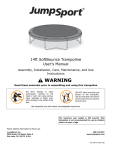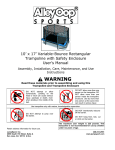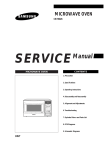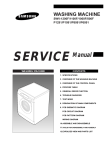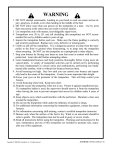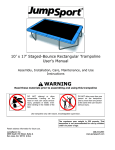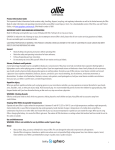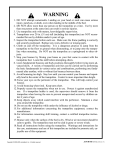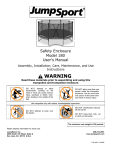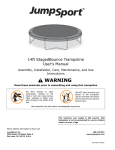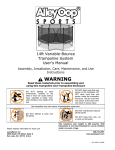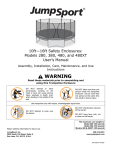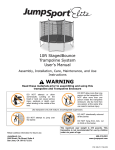Download Economy Trampoline User`s Manual
Transcript
14ft Economy Trampoline User’s Manual Assembly, Installation, Care, Maintenance, and Use Instructions WARNING Read these materials prior to assembling and using this trampoline DO NOT attempt or allow somersaults. Landing on the head or neck can cause serious injury, paralysis or death, even when landing in the middle of the bed. DO NOT allow more than one person on the trampoline. Use by more than one person at the same time can result in serious injury. Use trampoline only with mature, knowledgeable supervision. The maximum user weight is 200 pounds. This trampoline is not recommended for use by children under six years of age. Retain address information for future use. JumpSport, Inc. 2055 South 7th Street, Suite A San Jose, CA 95112 U.S.A. 408-213-2551 www.jumpsport.com 1 P/N: INS-P-10019B Copyright Notice This material is protected by United States copyright laws and is proprietary to JumpSport, Inc. Disclosure, reproduction, translation, modification, or use of this document by anyone other than authorized employees, authorized users, or licensees of JumpSport without the prior written consent of JumpSport, Inc. is prohibited. The information in this document is subject to change without notice. JumpSport, Inc. shall not be liable for any damages resulting from technical errors or omissions, which may be present in this document, or from use of this document. Copyright © 2006, by JumpSport, Inc. All rights reserved. Printed: 2006 Instruction Manual P/N: INS-P-10019B JumpSport 14ft Economy Trampoline P/N: TRJ-S-10173A Trademarks JumpSport® and SureStep™ Trampoline Ladder are trademarks of JumpSport, Inc. All other brand or product names are trademarks or registered trademarks of their respective companies or organizations. Patents This product includes technology associated with one or more of the following U.S. Patents: No. 6,053,845 No. 6,261,207 No. 6,840,891 No. 6,846,271 Additional Patents Pending. How to Contact Customer Support Should you require customer service or technical support for your JumpSport 14ft Economy Trampoline, please contact JumpSport’s Customer Service department at: 408-213-2551 8:00am—5:00pm Monday through Friday, Pacific Time 2 Contents Chapter 1 Introduction 5 JumpSport Safety Enclosure Chapter 2 Chapter 3 6 Assembly and Installation Instructions 7 Preparation Trampoline Placement Tools Parts List Assembly Final Steps Disassembly 7 7 8 8 10 15 15 Care and Maintenance Instructions Inspection Trampoline Mat Cold Weather Protection Replacement Parts Disassembly Care and Maintenance Safety Checklist Windy Conditions Moving the Trampoline Care Chapter 4 Warning Information Points of Safety Landing on Springs or Frame Bouncing off the Trampoline Landing Incorrectly on the Mat Chapter 5 Use Instructions 17 17 17 18 18 18 19 20 20 20 21 21 21 21 22 23 Safety Rules Basic Skills Bouncing Stop Bounce Arm Action Bounce Variations Basic Landing Positions Seat Drop Hands and Knees Drop Front Drop Series of Drops Twisting Moves Swivel Hips Turntable Twist Variations 23 24 24 24 24 25 25 25 26 26 27 27 27 28 28 Warranty Information 3 Last Page (This page left intentionally blank.) 4 Introduction 1 Congratulations on purchasing a JumpSport trampoline! We sincerely believe that you have purchased the finest economy trampoline on the market. It has been engineered with safety, durability, and performance in mind. Safe use of a trampoline also requires adequate knowledge of technique, as well as what not to do. Please read this manual thoroughly for key points of safety. Trampolines, being rebounding devices, propel the performer to unaccustomed heights and into a variety of body movements. Therefore, it is emphasized that all purchasers, and all persons using the trampoline, become familiar with the rules for safe use. Misuse and abuse of this trampoline is dangerous, and can cause serious injuries. The purchaser/ user of this piece of equipment is assuming a degree of risk for which JumpSport cannot be responsible. Read this information thoroughly before allowing the trampoline to be used. Keep this manual available for your review, and for review by all potential users. If there are questions please call JumpSport for further explanation. Caution JumpSport trampolines are designed exclusively for the home backyard market. Many users of our trampolines are children, and therefore need close supervision and rules to follow while playing on the trampoline. These rules must be enforced by whomever is responsible for the care of the children. It is strongly recommended that the buyer of this product go over the rules and recommendations in the packet of information supplied, including those in this manual. It is also strongly recommended that these rules and recommendations be supplemented with those of your own, for example: the time that jumping is allowed, when neighbors can visit, and so on. These rules and recommendations should be reviewed with anyone who is going to jump on the trampoline. If it is possible, review these rules with the parents or guardians of any visitors who may be jumping on the trampoline. See Safety Rules (under the Use Instructions section) for more information. Recommended weight limitation is no more than 200 pounds. Persons at, or near this weight should test the resiliency of the springs prior to extensive bouncing. Do this by jumping lightly on the mat. If the resiliency appears to be weak (mat does not lift the individual when light jumps are made), discontinue bouncing immediately, take off the springs and inspect them. If the springs appear to be stretched out of shape, the mat should not be put back on until the springs have been replaced. Be sure to check the mat for any areas that need re-stitching, or V-rings that may need replacing. We also urge you to not keep any ladder, step stool, or other climbing device next to the trampoline when use of the trampoline is not supervised by an adult. This precaution helps to prevent access to the trampoline by individuals that are too small, or do not have the physical strength necessary to jump on a trampoline without having the proper supervision. 5 Introduction Due to the risks associated with users falling off of trampolines, we strongly urge you to use a JumpSport Safety Enclosure in conjunction with your trampoline. Please call JumpSport if you have any questions about such a device. JumpSport Safety Enclosure Studies show that many of the injuries associated with trampoline use in a residential setting are a result of the user falling off of the trampoline and hitting the ground or some other object. For this reason, it is strongly recommended that a JumpSport Safety Enclosure be used in conjunction with your trampoline. The JumpSport Safety Enclosure should be used as a supplement to mature, knowledgeable supervision – not a substitute. The JumpSport enclosure can also be locked to prevent unauthorized use. Please contact JumpSport to learn more about our patented Safety Enclosures. Protect your family with a JumpSport Safety Enclosure. Diagram 1 JumpSport Safety Enclosure 6 Assembly and Installation Instructions 2 Preparation Before you begin assembling your JumpSport 14ft Economy Trampoline, make sure your trampoline is in a proper location. Trampoline Placement Caution: When deciding on where to place your trampoline, consider the following: WARNING Overhead Clearance Adequate overhead clearance is essential. A minimum of 24 feet from ground level is recommended. Provide clearance for wires, tree limbs, and other possible hazards. Lateral Clearance Lateral clearance is essential. Place the trampoline away from walls, structures, fences, and other play areas. Maintain a clear space on all sides of the trampoline. Level Surface Place the trampoline on a level surface before use. Lighting Use the trampoline in a well-lit area. Artificial illumination may be required for indoor or shady areas. Security Secure the trampoline against unauthorized and unsupervised use. Ground Clearance Remove any obstructions from beneath the trampoline. Note: The owner and supervisors of the trampoline are responsible to make all users aware of practices specified in the Use Instructions. It is the responsibility of the purchaser to become familiar with all of the information in this booklet, to convey the warnings to all users, and to enforce JumpSport’s rules for safe use. This unit is not intended for commercial or public use and is therefore strictly prohibited. The maximum user weight is 200 pounds. This trampoline is not recommended for use by children under six years of age. 7 Assembly and Installation Instructions Tools No tools are required for installation of the trampoline. However, safety glasses and gloves are recommended for safety. Parts List Your 14ft Economy Trampoline is shipped with the parts shown below. The trampoline parts ship in 2 separate boxes which may arrive on different days. If any parts are missing, immediately call JumpSport Customer Service at 408-213-2551. Reference # Part # 1 CAB-P-10116A 2 PLC-P-10141A 3 RAI-P-10012A 4 RAI-P-10013A 5 LEG-P-10014A 6 LEG-P-10015A 7 LEG-A-10259A 8 MAT-P-10016A 9 SPR-P-10023A 10 PAD-P-10018A Description Quantity Cable tie 1 Warning placard 1 Rail piece with no leg sockets, 10 spring notches 4 Rail piece with 2 leg sockets, 10 spring notches 4 Vertical leg piece 8 Horizontal leg piece 2 Horizontal leg piece, with sticker 2 Mat, 80 V-rings 1 Spring, 7 inches 80 Frame pad (one piece) 1 8 Assembly and Installation Instructions The following pages contain diagrams, pictures, and written instructions for assembling your 14ft Economy Trampoline. The “Ref. #” mentioned in many Steps is referring to the “Reference #” column of the parts list on the previous pages. Before performing any Step, completely read the entire Step first. For installation questions, please contact JumpSport’s Customer Service department at: 408-213-2551 8:00am—5:00pm Monday through Friday, Pacific Time CAUTION Pinch point. Pay careful attention to hand position when connecting tubes and handling springs. 9 Assembly and Installation Instructions Assembly Note: We recommend at least 2 people participate in assembling the trampoline. Use page 8 to help with part names and numbers. Rail with 2 leg sockets Ref. #4 Rail with no leg sockets Ref. #3 Vertical leg piece Ref. #5 Horizontal leg piece Ref. #6 or #7 2) Using 1 horizontal leg piece and 2 vertical leg pieces, build a leg assembly as shown above. (Top view) 1) Lay all rail and leg pieces in a circle as shown. >> Repeat with all remaining leg pieces. When finished, you will have 4 complete leg assemblies. Leg assembly 3) Stand 1 leg assembly upright and connect a rail with 2 sockets 4) Connect another leg assembly to the same rail with 2 sockets. as shown. 10 Assembly and Installation Instructions 5) Connect rail with no sockets, then rail with 2 sockets. 6) Connect next leg assembly to rail with 2 sockets. >> Repeat Steps 5 and 6 all the way around until all rail pieces and leg assemblies are attached. 7) Completed frame. 11 Assembly and Installation Instructions Mat Ref. #8 Warning label on mat facing up Spring Ref. #9 Warning label on mat facing up (Top view) 8) Connect jumping mat to trampoline frame using 4 springs. Connect each spring to a V-ring and spring notch, approximately 1/4 circle apart from each other. Warning labels must face up. TIP: To aid with pulling each spring toward you and hooking it into the notches on the frame, use a second spring as a tool to hook onto the one you are pulling. This will give you more leverage and make pulling the springs to the notches much easier. Note: For this Step, the springs do not have to be perfectly spaced. They are to help keep tension on the mat while you attach the remaining springs. Spring Ref. #9 V-rings Spring Ref. #9 Spring notches (Top view) (Top view) 9) Start at a spring that is already connected. While standing 10) Continue counting 4 V-rings and notches and connecting a outside the frame, count 4 V-rings and spring notches clockwise, spring until you have gone all the way around the trampoline. and connect another spring. The easiest way to connect a spring is to hook spring onto V-ring, then pull it toward you and hook it When you get to a spring that you connected in Step 8, reposition into spring notch on top of frame rail. it if necessary, so that the springs are all spaced exactly 4 V-rings and spring notches apart. 12 Assembly and Installation Instructions Person 2 (Top view) (Top view) Person 1 11) Now connect a spring to every middle V-ring and spring 12) Connect all the remaining springs to the trampoline, again notch, working clockwise around the trampoline. Have someone working clockwise, with someone working across from you. work across from you, also going clockwise. Note: It is important to have someone working across from you. Otherwise the springs could become over-extended, causing them to become difficult to attach. Frame Pad Ref. #10 Slits in pad skirt WARNING: Trampoline use is not recommended without the frame pad installed (see Picture A on page 15). The frame pad is designed to reduce the possibility of injury by protecting the user from coming into contact with the frame and springs of the trampoline. It is very important that you properly and securely attach the frame pad to the frame, and that it is in the correct position prior to using the trampoline. 13) Lay frame pad on trampoline, with connections facing down. Align pad so that slits on outside edge of pad skirt, line up over each leg of trampoline. If they do not line up, rotate pad to an adjacent leg. 13 Assembly and Installation Instructions Pad strap on bottom of frame pad 14) Tie pad strap (located on bottom of frame pad) loosely around frame rail. Be sure the knot is tight, but that there is plenty of slack. Cable tie Ref. #1 Warning placard Ref. #2 15) Attach warning placard to rail of trampoline using cable tie. Place placard where it will be most easily seen by those accessing the trampoline. 14 Assembly and Installation Instructions Final Steps Assembly is now complete! Make sure all parts are securely assembled. Before using your 14ft Economy Trampoline, familiarize yourself and all users with the Care and Maintenance Instructions, Warning Information, and Use Instructions included in this manual. To register your 14ft Economy Trampoline, visit our webpage at www.jumpsport.com and click on the Product Registration link. WARNING: Trampoline use is not recommended without the frame pad installed (see Picture A, below). The frame pad is designed to reduce the possibility of injury by protecting the user from coming into contact with the frame and springs of the trampoline. It is very important that you properly and securely attach the frame pad to the frame, and that it is in the correct position prior to using the trampoline. Picture A Frame Pad Placement - Showing Correct Placement over Frame Rails and Springs (Section of frame pad removed for clarity. Be sure pad is completely installed before use.) Disassembly To disassemble the 14ft Economy Trampoline, follow the assembly Steps in reverse order. Do not attempt to disassemble any rail pieces before the mat and springs have been removed. For more information about the SureStep Ladder, the Trampoline Anchor Kit, and other great trampoline accessories, visit our website at www.jumpsport.com 15 Assembly and Installation Instructions (This page left intentionally blank.) 16 Care and Maintenance Instructions 3 Your JumpSport trampoline is made using quality materials and is finely-crafted to provide you and your family with many years of enjoyment and exercise. Proper maintenance and care will help to prolong the life of the trampoline and reduce the possibility of injury. All trampolines require maintenance at some point. Springs may need to be replaced, rail pieces may become bent, stitching in the mat and frame pads may rot out. The following maintenance guidelines should always be observed. Inspection Inspect the trampoline before each use and replace any worn, defective, or missing parts. The following conditions could represent potential hazards: • • • • • • • Missing, improperly positioned, or insecurely attached frame padding Puncture, frays, tears, or holes worn in the bed or frame padding Deterioration in the stitching or fabric of the bed or frame padding Ruptured springs A bent or broken frame A sagging bed Sharp protrusions on the frame or suspension system Note: The “bed” mentioned above and elsewhere in this manual, refers to the jumping surface (generally referred to as the “mat”). The “frame” mentioned refers to the rail assembly pieces of the trampoline. If any of the above conditions exist, your 14ft Economy Trampoline must be disassembled or otherwise protected against use until the condition is remedied. Trampoline Mat An item that poses one of the greatest hazards, is worn out or rotten stitching around the trampoline mat (bed). Stitching may fail within two or three years or earlier due to excessive use or exposure to extreme weather. In most cases, evidence of deterioration will make itself known in the form of: • • Broken stitching around the edge of the mat Rotten or frayed fabric at the V-ring straps Caution: If any deterioration is found, all bouncing must cease and the trampoline must be disassembled or otherwise protected against use until the condition is remedied. The mat should be replaced with the appropriate JumpSport part. Remember, the only thing between the jumper and the ground is the mat. If a deteriorated mat is not inspected properly, further jumping could cause the mat to pull away from the straps in a large area and the jumper may land on the ground, which could cause serious injury. 17 Care and Maintenance Instructions Cold Weather Protection The 14ft Economy Trampoline is designed for year-round outdoor use. However, in climates of cold weather where snow and ice are common, we recommend the trampoline mat, springs, and frame pad be removed and stored in a dry area out of the sun. To remove these parts, simply complete the instructions for installing them in reverse order. Ice and Snow Use extreme care in removing any ice and snow that may have accumulated on the mat before removing the mat for storage. We suggest using a high pressure water hose and spraying upward from underneath the trampoline, starting at the mats lowest point. Another option is to pour hot water on the ice and snow to melt it away. Left unattended in snow and ice, your trampoline mat will accumulate weight in the middle, causing damage to your springs. This type of damage is not covered by warranty. Do not use a sharp object - such as a shovel, hoe, or garden rake - to remove ice or snow as this may damage the mat. This type of damage is not covered by warranty. Replacement Parts All replacement parts should be ordered through JumpSport. Stores that repair shoes, awnings, or tents, as well as upholstery shops, do not have the proper materials, equipment, or methods for the proper/safe repair of trampoline mats and frame pads. Call JumpSport at 408-213-2551 if you need replacement parts, or have any questions. If any warning labels or signs become unreadable or missing, call JumpSport for free replacements. Trampoline mats should be completely replaced if any tear or hole is greater than one inch in length. Patches over larger holes will eventually fail, creating a potential for hazardous injury. Caution: Do not repair trampoline mats with holes greater than one inch. Disassembly To disassemble, follow the assembly Steps in reverse order. Do not attempt to disassemble any rail pieces before the mat and springs have been removed. See the Assembly Instructions beginning on page 10. 18 Care and Maintenance Instructions Care and Maintenance Safety Checklist Note: Inspect the trampoline before each use and replace any worn, defective, or missing parts. Frame Pad Our frame pad reduces the risk of accidental injury due to falling onto the frame railing and gives minimal resistance to striking or falling on and through the springs. The frame pad life-expectancy is one to two years. To increase life of pad: • Do not allow jumpers to stand or sit on pad • Do not allow jumpers to grab pad in order to pull themselves onto trampoline • Do not allow sharp, abrasive objects to come in contact with the pad surface • If you have a safety enclosure installed, rotate the pad periodically to spread out wear and tear Safety Check Check for… Necessary Action Safe Unsafe Vinyl deterioration Replace _______ _______ Foam deterioration Replace _______ _______ Missing pads Replace _______ _______ Improperly attached pads Reattach (see pad installation _______ _______ _______ _______ section of instructions) Stitching deterioration Trampoline Mat Re-stitch The trampoline mat requires periodic re-stitching maintenance every two to three years. Normal mat life is approximately five to eight years with two re-stitchings. Make sure the trampoline is visually inspected by a responsible adult, checking the stitching carefully at each V-ring before every use. See Trampoline Mat on page 17 for more information. Safety Check Springs Check for… Necessary Action Safe Unsafe Bent or missing V-rings Replace V-rings _______ _______ Faded and breaking top thread Regular re-stitch _______ _______ Brittle and tearing V-ring straps Complete re-stitch _______ _______ Cuts, tears, or holes on mat Patch (holes greater than one inch cannot be repaired) _______ _______ Missing warning labels Call JumpSport for replacement _______ _______ The life of a set of springs is three to five years depending on weight of jumpers, frequency of use, and care of the trampoline. Safety Check Check for... Necessary Action Safe Unsafe Over-stretched springs Replace _______ _______ Missing springs Replace _______ _______ Weak (soft) springs Replace _______ _______ 19 Care and Maintenance Instructions Frame The life of your JumpSport trampoline frame should last for many years, depending upon the weather in the area where you live. Safety Check Safety Rules Check for... Necessary Action Safe Unsafe Rust Clean and paint _______ _______ Structural failure Replace _______ _______ Bent frame Repair or replace part _______ _______ Sharp protrusions Repair _______ _______ Missing warning labels Call JumpSport for replacement _______ _______ Review this manual with all jumpers. Maintain all warning labels and signs. If labels or signs become lost or unreadable, write or call JumpSport for free replacements. Windy Conditions It is possible for the trampoline to be blown about by a high wind. If you anticipate high winds, the frame should be secured to the ground with the use of an JumpSport Trampoline Anchor Kit. If you anticipate severe winds, the trampoline should be moved to a sheltered location or completely disassembled. Our anchor kit can be found in the Accessories section at www.jumpsport.com. Diagram 2 JumpSport Trampoline Anchor Kit Use a JumpSport trampoline anchor kit to tie down your 14ft Economy Trampoline. Moving the Trampoline If you need to move your trampoline periodically, it should be moved by at least two people, and kept horizontal during the move. Both people should stand next to each other on one of the short ends of the trampoline, and lift that end of the trampoline. Rotate that end of the trampoline about five feet, then go to the opposite end of the trampoline, and do the same thing. This will slowly rotate each end of the trampoline toward your desired destination, and is the easiest way to move the trampoline due to its heavy weight. Disassemble the trampoline for any move greater than a few feet. Care Do not allow family pets on the trampoline, as claws may snag and pull the trampoline mat material or damage the frame pad. The 14ft Economy Trampoline is intended to be used by one person at a time, weighing less than 200 pounds. The user should either be barefoot or wearing gymnastic slippers or non-cleated athletic shoes. The user should remove all sharp objects from their person that may cause injury or damage to the trampoline mat. Heavy, sharp, or hard pointed objects should not contact the mat surface. 20 Warning Information 4 WARNING DO NOT attempt or allow somersaults. Landing on the head or neck can cause serious injury, paralysis or death, even when landing in the middle of the bed. DO NOT allow more than one person on the trampoline. Use by more than one person at the same time can result in serious injury. Use trampoline only with mature, knowledgeable supervision. Points of Safety It is essential that trampoline users follow a carefully planned safety program so that the trampoline can be fully enjoyed. Most accidents can be classified into the following: • • • Landing on springs or frame Bouncing off the trampoline Landing incorrectly on the mat These are covered in detail in the following sections. Landing on Springs or Frame The risk of falling on the springs or frame, landing between the springs, or hitting the frame can be reduced by: • • • • Proper mounting and dismounting of the trampoline Jumping at the center of the mat without traveling toward the side Properly installing the frame pads Properly installing a JumpSport safety enclosure Simple frame pads or spring covers on their own do not give adequate protection. Installing the JumpSport Safety Enclosure and using spotters, will greatly reduce the risk of injury. Bouncing off the Trampoline Bouncing off of the trampoline can be controlled, if not completely eliminated, through: • • • • • • Proper instruction and mastering of the “Stop Bounce” technique in the “Basic Skills” section Maintaining a position in the center of the mat Strictly forbidding any “flying dismounts” (i.e. jumping off of the trampoline onto another object or the ground) Installing a JumpSport Safety Enclosure Using spotters Using the trampoline only with mature, knowledgeable supervision Keep objects away from the trampoline. It is dangerous to jump from the trampoline to the floor or ground. Do not jump from the trampoline into a swimming pool, onto a swing, or any other object. Do not install the trampoline on concrete, asphalt or hard compacted surfaces. 21 Warning Information Landing Incorrectly on the Mat Landing incorrectly on the mat creates great risk of a serious injury, with most injuries resulting from attempted somersaults/flips. It is strongly recommended that somersaults/flips are not performed. 22 Use Instructions 5 Safety Rules It is the responsibility of the owner to become familiar with the safety rules and to convey these rules to all users. WARNING • • • • • • • • • • • • • • • • • • DO NOT attempt or allow somersaults. Landing on your head or neck can cause serious injury, paralysis, or death, even when landing in the middle of the bed. DO NOT allow more than one person on the trampoline. Use by more than one person at the same time can result in serious injuries. Use trampoline only with mature, knowledgeable supervision. Trampolines over 20 inches (51 cm) tall are not recommended for use by children under 6 years of age. Inspect the trampoline before each use. Make sure the frame padding is correctly and securely positioned. Replace any worn, defective, or missing parts. Climb on and off the trampoline. It is a dangerous practice to jump from the trampoline to the floor or ground when dismounting, or to jump onto the trampoline when mounting. Do not use the trampoline as a springboard to other objects. Stop bounce by flexing knees as feet come in contact with the trampoline bed. Learn this skill before attempting others. Learn fundamental bounces and body positions thoroughly before trying more advanced skills. A variety of trampoline activities can be carried out by performing the basic fundamentals in various series and combinations, performing one fundamental after another, with or without feet bounces between them. Avoid bouncing too high. Stay low until bounce control and repeated landing in the center of the trampoline can be accomplished. Control is more important than height. While keeping the head erect, focus eyes on the trampoline toward the perimeter. This will help control bounce. Avoid bouncing when tired. Keep turns short. Properly secure the trampoline when not in use. Protect it against unauthorized use. If a trampoline ladder is used, the supervisor should remove it from the trampoline when leaving the area to prevent unsupervised access by children under 6 years of age. Keep objects away which could interfere with the performer. Maintain a clear area around the trampoline. Do not use the trampoline while under the influence of alcohol or drugs. For additional information concerning the trampoline equipment, contact the manufacturer. For information concerning skill training, contact a certified trampoline instructor. Bounce only when the surface of the bed is dry. Wind or air movement should be calm to gentle. The trampoline must not be used in gusty or severe winds. Read all instructions before using the trampoline. Warnings and instructions for the care, maintenance, and use of this trampoline are included to promote safe, enjoyable use of this equipment. Note: The “bed” mentioned above and elsewhere in this manual, refers to the jumping surface (generally referred to as the “mat”). The “frame” mentioned refers to the rail assembly pieces of the trampoline. 23 Use Instructions Basic Skills Basic trampoline skills include: • • • • Bouncing Stop Bounce Arm Action Bounce Variations Bouncing The most important basic skill in jumping on a trampoline, is controlling the height and landing of your bounce. The goal is to land in the center of the mat, or as close to the center of the mat as possible. The basic bounce should always being low. High, reckless bouncing should never be allowed. Stop Bounce The Stop Bounce technique allows the jumper to gain control by stopping quickly. It is done by keeping the feet in contact with the mat, and absorbing the rebound of the trampoline with the knees and waist. This skill should be learned right away and should be employed whenever you feel out of balance, or land away from the center area. To learn the Stop Bounce: 1. 2. 3. 4. Stand in center of the mat with your feet about hip-width apart. Attempt three easy bounces; keep them low and controlled. Focus your eyes toward the perimeter of the trampoline while bouncing, in order to keep your balance Stop the bounce when your feet contact the mat by bending at your knees and hips. Arm Action Arms are very important for proper control and lift. Whenever you go up, your arms go up. They go up to a set position about shoulder height and shoulder width. They should remain in this balanced position until you start to go down. Then they circle down slightly behind the hips, ready to lift again as you bounce up. See Figure 2. Figure 2 Arm Action 24 Use Instructions Bounce Variations Figure 3 shows three variations you can perform in the air. These should be performed at the top of your bounce before returning to the normal landing position on your feet. Figure 3 Bounce Variations Tuck Pike Straddle Practice these simple variations and concentrate on perfect form. When you are in position, make sure you point your toes and straighten your fingers (Pike and Straddle variations). Also make sure you take off and land in the same spot on the center of the mat. These simple variations to the basic bounce can be a lot of fun, and are very important for gaining experience in coordinated movement and balance. Basic Landing Positions Once the jumper understands the body placement of the position, the drop can be performed after “priming” the trampoline mat. Priming is done by bending the knees and pushing down on the trampoline mat several times, thereby setting the mat in motion. The feet stay in contact with the mat during the entire priming motion. Seat Drop Figure 4 Seat Drop To perform a Seat Drop: 1. From the standing position, prime the mat several times. 2. Pick up your feet at the top of the last bounce, and sit down. You should land with your body in a seated position with your legs straight out in front of you and your toes pointed. Hands should be on the mat next to your hips. Fingers should be together and pointed toward your feet. See Figure 4. 3. Push on the mat with your hands to rebound up to your feet. 25 Use Instructions Hands and Knees Drop To do a Hands and Knees Drop properly, there should be just as much weight on the hands as on the knees. The back should be about parallel to the mat. The knees and hands should land simultaneously, with the middle of the body landing in the center of the trampoline. The hands should be directly under the shoulders. The knees should be directly under the hips. The toes should be pointed. See Figure 5. To perform a Hands and Knees Drop: 1. Get down on your hands and knees on the mat. Make sure you have weight on both your hands and knees. Do not sit on your heels. 2. Remain in this position and try to bounce. Do not rock back and forth between the hands and knees, but develop an even landing on all four points. 3. From the standing position, prime the mat several times. Lift upward with the hips, reach forward with the hands, and land on all fours. Look slightly in front of your hands on landing. Push to rebound to your feet. Figure 5 Hands and Knees Drop Front Drop Figure 6 Front Drop In a front drop, contact with the trampoline mat should simultaneously take place with your hands, elbows, chest, stomach, and hips. Knees should be bent. Hands should be placed close together with palms in contact with the mat, forming a triangle. Eyes should focus on the center of the triangle or slightly in front of your fingers. See Figure 6. 1. First learn how to go from the hands and knees drop to the front drop. a. Start from the hands and knees drop position. b. As you rebound from the hands and knees, stretch so that you land on your stomach. From this position, rebound to your hands and knees. 2. Next, perform Step 1, beginning and ending in a standing crouched position. a. Start from a standing position with your knees bent and your upper body low and close to the trampoline mat. b. Prime the mat several times. c. Lift your hips gently upward and backward. d. Land in a hands and knees drop, rebound and stretch into a front drop, and return to a hands and knees drop. e. Push with the hands to return to your feet. 3. Lastly, perform Step 2 from a standing position. a. Start from a straight standing position. b. Prime the mat several times. c. Perform a Front Drop as in Step 2. 26 Use Instructions Front Drop Note: Your body must contact the trampoline mat all at once. If you land on your chest and arms first, they will rebound before the knees hit, which will result in a straining action on the back. If this type of landing is made with a traveling, diving approach, there is a good chance that the elbows may become skinned. If the landing is made so that the knees and hips hit first, then they will rebound and you will land heavily on your shoulders and face. Series of Drops Once you have mastered the individual bounce variations and drops, try performing them in sequence. For example: Seat Drop—Hands and Knees Drop—Front Drop or Seat Drop—Hands and Knees Drop—Seat Drop. Twisting Moves Twisting moves include: • • • Swivel Hips Turntable Twist Variations Swivel Hips A Swivel Hips is a combination move consisting of a Seat Drop, half twist, then another Seat Drop. 1. First become familiar with the first part of a Swivel Hips. a. Perform a seat drop. b. Push down on the mat with the hands and straighten in the air with your arms stretched over your head. 2. Next, add the half twist. a. Perform Step 1. As you rebound up to your feet, move one shoulder in the direction you want to twist. b. Finish standing with arms stretched overhead, facing the opposite direction (180 degree twist completed). 3. Last, try the complete Swivel Hips twist. See Figure 7. a. Perform a Seat Drop. b. As you rebound with your arms overhead, twist around to face the opposite direction. c. Land in another Seat Drop. Figure 7 Swivel Hips 27 Use Instructions Turntable A Turntable is a combination move consisting of a Front Drop, a Half Twist, then another Front Drop. 1. 2. 3. 4. Figure 8 Turntable First become familiar with the first part of a Turntable. a. Begin in a hands and knees position, with hands forming a triangle, like a Front Drop. b. Prime the mat in this position. c. Push backward with your hands and extend your body to land in the Front Drop position. d. Repeat several times in succession: Hands and Knees Drop—Front Drop—Hands and Knees Drop, etc. Next, perform the movement in Step 1, but at twice the speed so as to bring the knees inward, under the hips and out again without touching the knees on the mat. Now, perform the movement in Step 2, but push sideways on the mat so that your body rotates before you land on the mat. Last, try the complete Turntable twist from a standing position. Prime the mat and perform a Front Drop. Push sideways, complete a 180 degree rotation, and finish in a Front Drop facing the opposite direction. See Figure 8. Twist Variations You can have hours and hours of fun and challenging bouncing by combining twists with each of the basic landing positions (Drops). You can twist after the landing. For example: Seat Drop with a half twist and land on your feet. You can add more twists. Always remember to practice and perfect the simpler twists before moving on to more complex twists. You can also perform a series of twists. For example: perform several Swivel Hips in a row, all in the same direction or alternate directions. You can do the same thing with Turntable twisting. If you find you love the trampoline and have mastered the moves discussed in these instructions, we encourage you to seek additional training from a certified trampoline instructor. 28 Use Instructions (This page left intentionally blank.) 29 Use Instructions (This page left intentionally blank.) 30 Limited Warranty What is covered by this warranty? This warranty covers any defects in materials or workmanship on all of the components of the JumpSport 14ft Economy Trampoline, and is extended exclusively to the original retail purchaser. How long does this coverage last? Warranty coverage for each component begins from the original date of purchase and lasts as follows: • Steel frame – warranted for 5 years • Fabric on jumping surface (mat) – 2 years • Stitching on mat (includes V-rings and straps that hold the V-rings in place) – 2 years • Springs – 2 years • Frame pad – 6 months What will JumpSport do? If you return the defective part to JumpSport, as instructed below, JumpSport will either repair or replace such part, at JumpSport’s discretion, and return it to you. What is not covered by this warranty? This warranty does not cover expenses of on-site labor, travel, assembly or disassembly, or other charges associated with the repair or replacement of covered components. This warranty also does not cover any problem that is caused by abuse, misuse, commercial or public use, ordinary wear and tear, weathering, acts of God (such as wind and lightning), failure to follow directions, improper installation, or improper maintenance. Rust is a natural occurrence with any outdoor steel product and is likewise not covered by this warranty, to the extent that it does not affect the structural integrity of the part. JUMPSPORT IS NOT RESPONSIBLE OR LIABLE FOR INDIRECT, SPECIAL, OR CONSEQUENTIAL DAMAGES ARISING OUT OF OR IN CONNECTION WITH THE USE OR PERFORMANCE OF THE PRODUCT OR OTHER DAMAGES WITH RESPECT TO ANY LOSS, INCLUDING BUT NOT LIMITED TO ECONOMIC LOSS, LOSS OF PROPERTY, LOSS OF REVENUE OR PROFITS, LOSS OF ENJOYMENT OR USE, COST OF REMOVAL, INSTALLATION OR OTHER CONSEQUENTIAL DAMAGES. SOME STATES DO NOT ALLOW THE EXCLUSION OR LIMITATION OF INCIDENTAL OR CONSEQUENTIAL DAMAGES. ACCORDINGLY, THE ABOVE LIMITATION MAY NOT APPLY TO YOU. THE WARRANTY EXTENDED HEREUNDER IS IN LIEU OF ALL OTHER WARRANTIES AND ANY IMPLIED WARRANTY OF MERCHANTABILITY OR FITNESS FOR A PARTICULAR PURPOSE IS LIMITED IN ITS SCOPE AND DURATION TO THE TERMS SET FORTH HEREIN. SOME STATES DO NOT ALLOW LIMITATIONS ON HOW LONG AN IMPLIED WARRANTY LASTS. ACCORDINGLY, THE ABOVE LIMITATION MAY NOT APPLY TO YOU. How to get a defective part replaced: 1) 2) 3) Call the JumpSport Customer Service department at 408-213-2551 to obtain a Return Authorization number. All returns must be pre-authorized. Send the part(s) to the designated Service Center, along with a copy of your original sales receipt and a brief written description of the problem, including how it occurred. You must pay freight and insurance to return the part to JumpSport. At JumpSport’s sole discretion, we may ask you to send photographs in addition to or in lieu of returning the part. After inspecting the returned part(s), JumpSport will make a final determination whether the part is covered by this warranty. We reserve the right to examine photographs or physical evidence concerning parts claimed to be defective prior to making a final determination concerning the claim. A repaired or replacement part will be returned to you. Please allow 3 to 4 weeks for delivery. This warranty gives you specific legal rights. You may also have other rights which vary from state to state. 31 JumpSport, Inc. 2055 South 7th Street, Suite A San Jose, CA 95112 408-213-2551 http://www.jumpsport.com 32
































